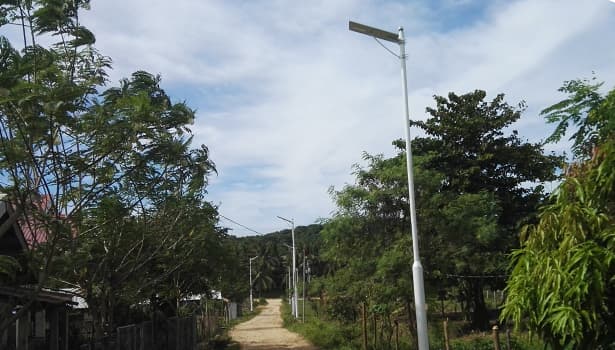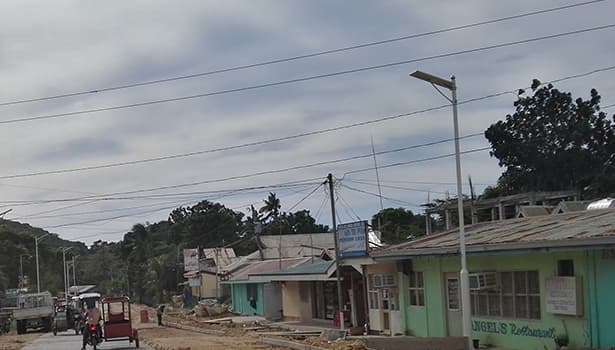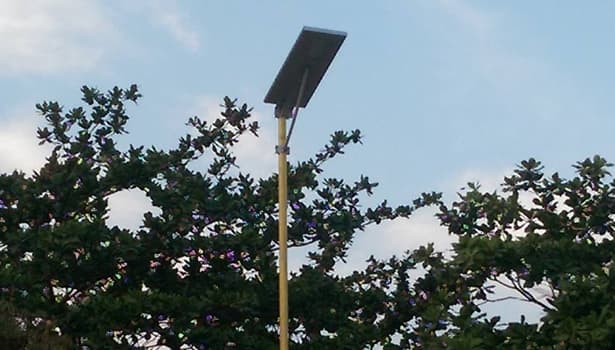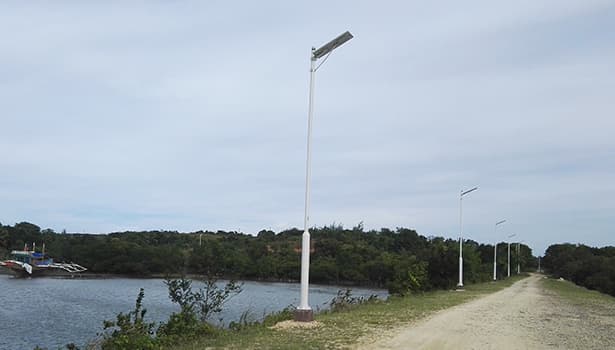The Benefits of Solar Street Lights in the Philippines
Mar 06, 2025
As a tropical country, the Philippines faces many challenges in its energy mix and lighting situation. The cost of electricity in the country is one of the highest in Asia, averaging about Php 9 - 10 per kilowatt hour (kWh). Not only that, but in the vast rural areas, the old grid infrastructure leads to frequent power outages, which seriously affects the lives of the residents and economic development. For example, in some remote villages, the lack of reliable lighting at night makes it extremely inconvenient for residents to get around and traffic accidents are frequent, while also providing opportunities for crime.
Against this backdrop, solar streetlights have become a key solution to the Philippines' energy, environmental and infrastructure dilemmas. It not only relieves the pressure on energy and reduces dependence on the traditional power grid, but also helps protect the environment, promotes sustainable development, and brings new vitality to infrastructure development in cities and villages.

The Philippines receives an average of 4.5 - 5.5 kWh of solar energy per square meter per day, which is among the highest in Southeast Asia, fully demonstrating its abundant solar energy potential. According to the Philippine Solar Potential Study, such abundant light resources lay a solid foundation for the widespread use of solar energy.
Lighting Hope for Remote Areas
For many remote and off-grid areas in the Philippines, traditional grid power is difficult and costly. Solar streetlights, with their inexhaustible solar energy, have become a cost-effective alternative for lighting in these areas. Without the need to lay complex grid lines, solar streetlights can operate independently, providing stable lighting for roads and communities in remote villages, greatly improving the living conditions of local residents.
The high cost of electricity in the Philippines is a burden for many businesses and households. The high cost of electricity has a serious impact on the profitability of businesses and increases the cost of living for residents. Under these circumstances, the search for low-cost energy solutions is urgent.
Grid Reliability Issues
The aging grid infrastructure in the Philippines is not able to cope with the daily demand for electricity, with frequent blackouts in rural areas. Solar streetlights are completely independent of the grid and are not affected by grid failures, providing stable lighting for roads in all weather and grid conditions, ensuring traffic safety and normal nighttime activities for residents.
The Philippines has responded positively to the Paris Agreement by committing to reduce its greenhouse gas emissions by 75 percent by 2030 and has developed a detailed Nationally Owned Contribution Implementation Plan. Solar streetlights play a crucial role in the journey to achieve this ambitious goal.
Significant Carbon Emission Reduction
Compared with conventional lighting, one solar streetlight can reduce carbon dioxide emissions by approximately 1.2 tons per year. The use of a large number of solar streetlights will have a significant cumulative effect on reducing carbon emissions in the Philippines, and will strongly contribute to the country's transition to a low-carbon economy.
Toward Green Infrastructure
The widespread installation of solar streetlights demonstrates the Philippines' determination to actively adopt renewable energy technologies in urban and rural development, helping to build a greener and more sustainable infrastructure system and create a better environment for future generations.

Solution:
Solutions:
Solution:
Solutions
Solutions
Solutions

Solar streetlights directly utilize solar energy to convert into electricity, greatly reducing dependence on non-renewable energy sources such as coal and oil, and contributing to the diversification of the Philippine energy mix and sustainable development.
Reducing Carbon Emissions and Electricity Consumption
As mentioned earlier, solar streetlights can significantly reduce carbon dioxide emissions annually while eliminating the need to consume conventional grid power, helping to ease the Philippines' tight power supply.
While the initial investment in solar streetlights is higher than that of conventional streetlights, in the long run, they save municipalities and businesses a lot of money by eliminating the need to pay for electricity and having lower maintenance costs.
Positive impact on municipal finances
For local governments, the long-term cost advantages of solar streetlights make them an economical and sensible choice, allowing savings to be invested in other important public services.
Specially designed solar street lights are able to withstand harsh weather such as typhoons and torrential rains in the Philippines, ensuring that they continue to function properly in extreme climatic conditions.
Continuous Lighting During Power Outage
During power outages, the solar street light can provide continuous lighting with its own energy storage system, ensuring road traffic safety and avoiding accidents caused by darkness.
Bright road lighting can effectively reduce the incidence of traffic accidents, and at the same time play a deterrent role in crime, creating a safer travel environment for residents.
Enhance community safety
Good lighting makes residents feel more secure when traveling at night, improving the overall sense of safety and quality of life in the community.
As a clean, renewable energy source, solar energy does not produce any pollutants during its use, in line with the Philippines' environmental philosophy of sustainable development.
Fits in with the Sustainable Development Goals
The widespread use of solar streetlights is highly compatible with the Philippines' goals of sustainable development and renewable energy utilization, and will help drive the country's progress in the field of environmental protection.
.jpg)

Choose a solar street light with sufficient battery capacity to ensure that it can store enough power to meet the lighting needs for the whole night and have a 3 - 5 day backup capacity for continuous rainy weather.
Battery Type Selection
Given the climatic characteristics of the Philippines, lithium iron phosphate (LifeP04) batteries are recommended. These batteries are highly resistant to high temperatures, have a long service life, and are safe from overheating and fire even under extreme conditions. Although they are 2-3 times more expensive than VRLA (gel batteries), they are more cost-effective when considering their longevity, efficiency and reliability.
Be wary of recycled batteries
Be wary of unscrupulous manufacturers and suppliers who use old batteries recycled from electric vehicles. These batteries typically last only about 1 year, far less than the 10 - 15 year life of lithium iron phosphate batteries.
Against this backdrop, solar streetlights have become a key solution to the Philippines' energy, environmental and infrastructure dilemmas. It not only relieves the pressure on energy and reduces dependence on the traditional power grid, but also helps protect the environment, promotes sustainable development, and brings new vitality to infrastructure development in cities and villages.

Why Solar Lighting in the Philippines is Crucial
1.Abundant solar energy resources in the Philippines
Unique light conditionsThe Philippines receives an average of 4.5 - 5.5 kWh of solar energy per square meter per day, which is among the highest in Southeast Asia, fully demonstrating its abundant solar energy potential. According to the Philippine Solar Potential Study, such abundant light resources lay a solid foundation for the widespread use of solar energy.
Lighting Hope for Remote Areas
For many remote and off-grid areas in the Philippines, traditional grid power is difficult and costly. Solar streetlights, with their inexhaustible solar energy, have become a cost-effective alternative for lighting in these areas. Without the need to lay complex grid lines, solar streetlights can operate independently, providing stable lighting for roads and communities in remote villages, greatly improving the living conditions of local residents.
2.Rising Energy Costs and Grid Challenges
High Electricity CostsThe high cost of electricity in the Philippines is a burden for many businesses and households. The high cost of electricity has a serious impact on the profitability of businesses and increases the cost of living for residents. Under these circumstances, the search for low-cost energy solutions is urgent.
Grid Reliability Issues
The aging grid infrastructure in the Philippines is not able to cope with the daily demand for electricity, with frequent blackouts in rural areas. Solar streetlights are completely independent of the grid and are not affected by grid failures, providing stable lighting for roads in all weather and grid conditions, ensuring traffic safety and normal nighttime activities for residents.
3.Environmental Protection and Sustainable Development Goals
A Solemn Commitment under the Paris AgreementThe Philippines has responded positively to the Paris Agreement by committing to reduce its greenhouse gas emissions by 75 percent by 2030 and has developed a detailed Nationally Owned Contribution Implementation Plan. Solar streetlights play a crucial role in the journey to achieve this ambitious goal.
Significant Carbon Emission Reduction
Compared with conventional lighting, one solar streetlight can reduce carbon dioxide emissions by approximately 1.2 tons per year. The use of a large number of solar streetlights will have a significant cumulative effect on reducing carbon emissions in the Philippines, and will strongly contribute to the country's transition to a low-carbon economy.
Toward Green Infrastructure
The widespread installation of solar streetlights demonstrates the Philippines' determination to actively adopt renewable energy technologies in urban and rural development, helping to build a greener and more sustainable infrastructure system and create a better environment for future generations.

Challenges and Solutions in Adopting Solar Lighting in the Philippines
1.High upfront costs
Challenge:The high upfront investment in solar streetlight systems, including solar panels, batteries, and installation costs, compared to traditional lighting systems, has deterred many municipalities and businesses from making decisions.Solution:
- Government incentives: Under the Renewable Energy Act of 2008, the Philippine government offers a range of financial incentives such as tax holidays, tariff exemptions, and special subsidies that can reduce upfront costs by 30-50%.
- Green Financing Channels: Programs such as the DBP Green Financing Program provide low-interest loans with flexible repayment terms for solar streetlight projects, effectively easing capital pressure.
- Phased implementation strategy: It is recommended to start with a small-scale project first, and then gradually expand the scale of the project after accumulating some experience and saving money through operation.
2.Maintenance and Durability Issues in Harsh Climate
Challenge:The Philippines is located in the tropics and often suffers from extreme weather such as typhoons, heavy rains and high humidity, which poses a severe test to the long-term durability and maintenance of solar streetlights.Solutions:
- Choose weather-resistant products: Priority should be given to solar streetlights with IP65-rated housings, which are effective in waterproofing and dustproofing. Meanwhile, the streetlights should be equipped with corrosion-resistant frames and reinforced structures to withstand strong winds.
- Work with reliable suppliers: Nokin solar street lights are specially designed for tropical climates, with reliable product quality and comprehensive warranty services.
- Establish a regular maintenance program: Regular inspections of solar streetlights, cleaning of solar panels and testing of battery performance ensure that the streetlights are always in optimal working condition.
3.Complex installation process
Challenges:Solar street light systems, especially those with intelligent control functions or complex projects that need to be connected to the power grid, require specialized technical knowledge for the installation process.Solution:
- Hire a professional installation team: Working with a qualified solar installation team ensures accurate installation. Many suppliers, such as Nokin Solar Street Lights, offer one-stop installation services.
- Comprehensive training for local teams: Train local staff in basic maintenance and troubleshooting to reduce reliance on external technical support and lower maintenance costs.
- Adoption of customized design solutions: In remote or complex construction conditions, choose pre-assembled, plug-and-play solar street light systems to simplify the installation process and shorten the construction cycle.
4.Safety and vandalism risk
Challenges:In rural or poorly serviced areas, solar streetlights are easy targets for theft and vandalism, which not only affects the normal use of streetlights, but also increases replacement costs.Solutions
- Install anti-theft devices: Use anti-pry fasteners and lockable battery boxes to prevent equipment theft. Some solar energy systems also have built-in GPS trackers to facilitate the recovery of stolen equipment.
- Community Involvement: Carry out publicity activities to enhance community residents' sense of ownership of solar streetlights. When residents realize the importance of streetlights to the community, they will be more active in protecting them.
- CCTV Integration: In high-risk areas, solar streetlights are combined with solar-powered CCTV cameras to improve security.
5.Lack of technical knowledge
Challenge:When choosing a solar streetlight system, decision makers are often confused by technical parameters such as battery capacity, panel efficiency or intelligent control, making it difficult to pick the product that best suits their needs.Solutions
- Simplified buying guide: Refer to relevant information to understand the key points of choosing solar street lights.
- Supplier consulting services: Communicate with trusted suppliers, such as Nokin Solar Street Light, who are able to provide professional product advice based on customer needs.
- Participate in training courses: Enroll in training courses and seminars organized by solar suppliers or government agencies to enhance your technical knowledge.
6.Regulatory and Approval Delays
Challenge:During project implementation, cumbersome regulatory requirements and approval processes often lead to project delays, especially in areas with strict local government regulations.Solutions
- Communicate with local governments as early as possible: Communicate with local governments at the beginning of the project to ensure that the project complies with regional planning, environmental and safety regulations.
- Optimize document preparation: Work with experienced project managers who are familiar with the regulatory process and can efficiently prepare the required documents for approval to speed up the approval process.
- Utilize a one-stop service platform: The Renewable Energy Service Contract (RESC) provided by the Philippine Department of Energy (DOE) offers one-stop and convenient services for renewable energy project approvals.

Benefits of Solar Street Lights in the Philippines
1.Efficient utilization of energy
Reduced dependence on non-renewable energy sourcesSolar streetlights directly utilize solar energy to convert into electricity, greatly reducing dependence on non-renewable energy sources such as coal and oil, and contributing to the diversification of the Philippine energy mix and sustainable development.
Reducing Carbon Emissions and Electricity Consumption
As mentioned earlier, solar streetlights can significantly reduce carbon dioxide emissions annually while eliminating the need to consume conventional grid power, helping to ease the Philippines' tight power supply.
2.Cost Effectiveness
Initial Investment and Long-Term ReturnWhile the initial investment in solar streetlights is higher than that of conventional streetlights, in the long run, they save municipalities and businesses a lot of money by eliminating the need to pay for electricity and having lower maintenance costs.
Positive impact on municipal finances
For local governments, the long-term cost advantages of solar streetlights make them an economical and sensible choice, allowing savings to be invested in other important public services.
3.Rugged and reliable
Resistant to harsh weatherSpecially designed solar street lights are able to withstand harsh weather such as typhoons and torrential rains in the Philippines, ensuring that they continue to function properly in extreme climatic conditions.
Continuous Lighting During Power Outage
During power outages, the solar street light can provide continuous lighting with its own energy storage system, ensuring road traffic safety and avoiding accidents caused by darkness.
4.Improve community safety
Reduce accidents and crimesBright road lighting can effectively reduce the incidence of traffic accidents, and at the same time play a deterrent role in crime, creating a safer travel environment for residents.
Enhance community safety
Good lighting makes residents feel more secure when traveling at night, improving the overall sense of safety and quality of life in the community.
5.Promoting Environmental Sustainability
Utilizing clean and renewable energyAs a clean, renewable energy source, solar energy does not produce any pollutants during its use, in line with the Philippines' environmental philosophy of sustainable development.
Fits in with the Sustainable Development Goals
The widespread use of solar streetlights is highly compatible with the Philippines' goals of sustainable development and renewable energy utilization, and will help drive the country's progress in the field of environmental protection.
.jpg)
Solar Street Light Applications
1.City Streets
In cities, solar streetlights provide stable lighting for roads and pedestrian areas, enhance the city's nighttime image, ensure the safety of citizens traveling at night, and also add a green, environmentally friendly atmosphere to the city.2.Rural Areas
In remote rural areas, solar streetlights solve the long-standing lighting problems, improve the living environment of rural residents, and promote nighttime economic activities and social development in rural areas.3.Parks and Public Spaces
The installation of solar street lights in parks and public spaces can extend the use of these areas, allowing residents to enjoy leisure and recreation time at night and enriching their spare time.4.Commercial Places
Solar street lights around commercial venues not only improve the safety of the venue, but also enhance the aesthetics of the commercial area through unique design, attracting more customers.5.Parking Lots
Installation of solar street lights in parking lots provides clear lighting for vehicles and pedestrians, reduces the risk of accidents, and improves the management efficiency and safety of parking lots.
How to Avoid the “Cheap Solar Street Light” Trap in the Philippines
1.Battery
Capacity & Backup PowerChoose a solar street light with sufficient battery capacity to ensure that it can store enough power to meet the lighting needs for the whole night and have a 3 - 5 day backup capacity for continuous rainy weather.
Battery Type Selection
Given the climatic characteristics of the Philippines, lithium iron phosphate (LifeP04) batteries are recommended. These batteries are highly resistant to high temperatures, have a long service life, and are safe from overheating and fire even under extreme conditions. Although they are 2-3 times more expensive than VRLA (gel batteries), they are more cost-effective when considering their longevity, efficiency and reliability.
Be wary of recycled batteries
Be wary of unscrupulous manufacturers and suppliers who use old batteries recycled from electric vehicles. These batteries typically last only about 1 year, far less than the 10 - 15 year life of lithium iron phosphate batteries.




